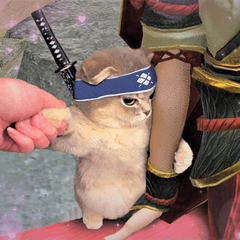Speedpainting tricks.
On the following video I will give you 10 little tricks to speed up your art and make nice effects to your illustration. Let's start!
Watch the video.
Here is a summary of the 10 tricks I give in the video.
1) Create a folder for all sketch layers.
If you put all your sketch layers into one folder, you can give the whole folder a color value so that all the layers you put inside will have the same color. The color is blue by default, but I like making mine red. Why do I do this? Because when I want to ink the sketch later, I will be able to see what I'm doing much better if the sketch is not black.
2) Use 3D objects for details that are hard to draw.
Whether it's glasses, goggles, a bag, a bicycle, etc., 3D objects are super useful on Clip Studio Paint. In this case, I'm using this object:
You only have to drag and drop the 3D object into the drawing and set the angle you want.
Then right click on the 3D object layer and select LT conversion of layer to extract the lineart (EX feature only).
*Having all lineart elements on vector layers is essential so as to change the appearance of the lineart (for a pencil texture, for example).
3) Placing the base color of each element on a different layer.
If you have one layer per element, it'll be a lot easier to shade them later without accidentally shading over converging elements (for example, when you're going to shade the hair it will not affect the coat if you separate everything properly). When you're going to apply shading or lights over an element, just create a new layer on top of it and click on the "clip to layer below icon".
*When you use textured pens to ink, the bucket will not work so well to apply base color. What I do is the following:
-Copy-paste the lineart folder.
-Hide one of the copies.
-Go to the vector lineart layer and change the brush shape to a normal pen.
-Now you can use the bucket to fill each area quite cleanly.
-Once you're done with base color, hide the copied lineart folder and enable the previous one with the textured lineart.
4) Set a light focus.
Just draw a cross anywhere on the canvas (on a layer you can hide or delete later) to decide where the light is coming from. Seeing it there will help you know what parts should be shaded.
5) Saving colors.
When you're working with colors that are not flat (for example, using watercolor brushes), it is important to have some way of retrieving the color you were using if you need to edit something later. What I do is to create a new layer (that I will hide or delete at the end) and I draw a circle with that color using a solid pen (such as maru/mapping pen), then when I need to use that color again all I have to do is to use the eyedropper.
*Additionally there's a window you can enable called "color history", which will save the list of colors you have been using. Finding a color that you used a while back when you were shading a certain element can be a bit tedious though, so I recommend my previous tip.
6) Be creative when it comes to brushes.
I started shading the fur parts with a cloud brush. You don't need to find specific brushes for specific parts, try out new things!
7) Use existing backgrounds to create new ones.
CLIP STUDIO PAINT comes with many backgrounds you can use, and there are even more to download from Assets. The way you mix them can also help you create new ones! For this illustration, for example, I mixed a galaxy background with one with clouds (using OVERLAY mode), and then changed the color using gradients and a COLOR layer mode along with extra lights with a SCREEN layer mode. Again, be creative and mix stuff to create the perfect atmosphere for your drawing.
8) Edit the character's colors to fit the background.
After you get the perfect background, you might feel like the character doesn't fit so well. What I do in these cases is to select all layers where the character is painted and I create a selection from those layers. Now all changes you apply will affect the character only. You can now edit the overall color scheme by creating a new correction layer on top of all the other character's layers (Layer -> New correction layer -> Color balance). You can also apply effects with the airbrush and other layer modes (SCREEN for lights, COLOR BURN for darkening, COLOR to alter colors, etc.)
9) Make a SCREEN layer to edit parts of the lineart + extra effects.
At the end I create a new layer in SCREEN mode and I draw lines to cover parts of the lineart where light is reflecting directly (for this I take into account the light focus I decided before). I also use this layer to add extra loose hairs if the background is dark (if the background was light, I'd probably use a MULTIPLY layer instead).
10) Add textures.
I drag and drop the texture I want and set it to OVERLAY. Then I go to Layer -> Layer Mask -> Mask outside selection. This will make the whole texture disappear, and now I can make parts of it appear where I want them by painting over the mask with the airbrush.
I hope you found these tricks useful!
About the artist.
If you like my stuff, you can check my social media (^^)
And to check a list of my tutorials across platforms, check my Tumblr:
























댓글